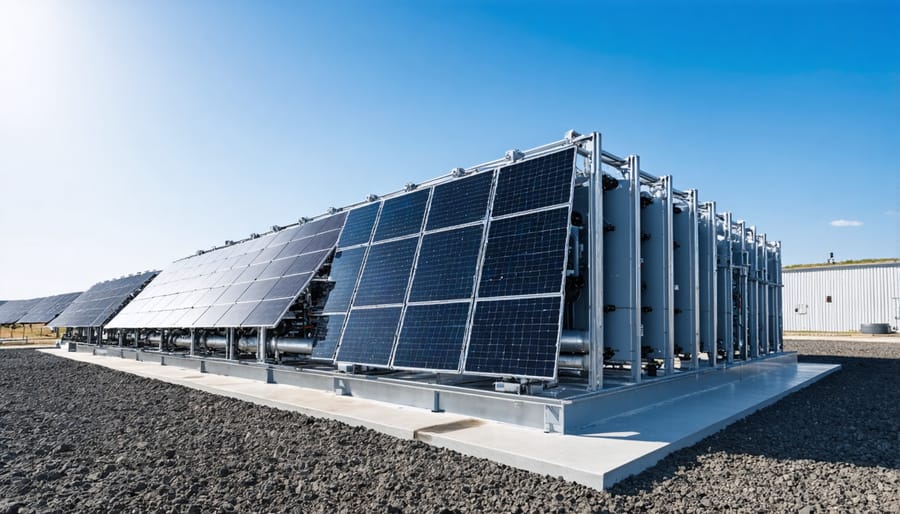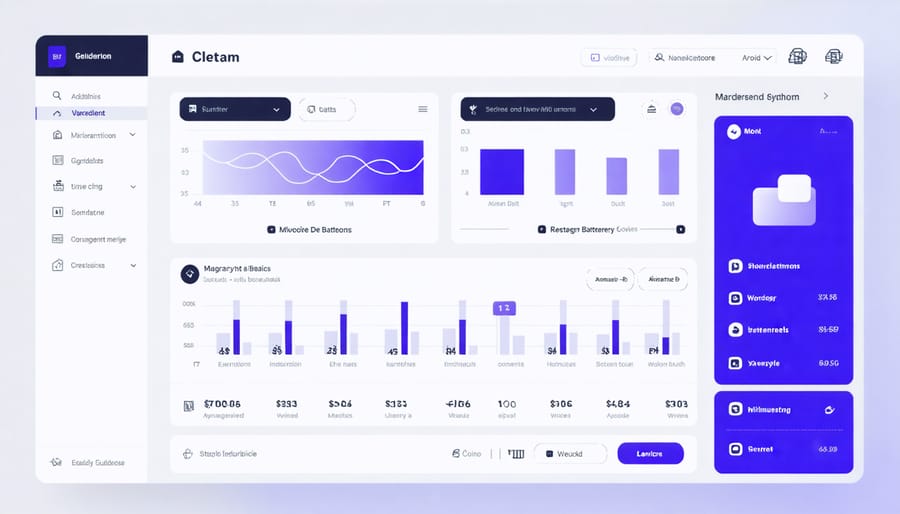These Advanced Battery Technologies Are Revolutionizing Solar Storage

The race for revolutionary energy storage has entered a transformative era, with high-tech battery solutions reshaping how Europe powers its sustainable future. From grid-scale installations to home energy systems, advanced battery technologies are unlocking unprecedented possibilities for energy independence and grid stability. Modern lithium-ion configurations, solid-state batteries, and flow battery systems now offer storage capacities exceeding 100kWh with round-trip efficiencies above 95%, fundamentally changing the economics of renewable energy integration.
These breakthrough storage solutions feature sophisticated battery management systems (BMS) that optimize performance, extend lifecycle, and ensure safe operation under diverse environmental conditions. With intelligent thermal management and predictive maintenance capabilities, today’s battery systems deliver reliable performance for 15+ years while maintaining up to 80% of their original capacity.
For European businesses and homeowners, these advanced storage technologies represent more than just backup power—they’re enabling smart energy management, peak shaving, and participation in emerging energy markets. As grid demands evolve and renewable integration accelerates, high-tech battery solutions stand at the forefront of Europe’s energy transition, offering scalable, efficient, and increasingly cost-effective energy storage options for every application.

Solid-State Batteries: The Next Generation of Solar Storage
Enhanced Safety and Durability
Modern high-tech battery solutions incorporate multiple layers of sophisticated safety mechanisms, setting new standards for reliable energy storage. Advanced Battery Management Systems (BMS) continuously monitor temperature, voltage, and current levels across individual cells, automatically adjusting parameters to prevent thermal runaway and overcharging incidents.
These smart batteries feature flame-retardant materials and robust mechanical designs that protect against physical damage. Multi-stage protection circuits work in tandem with specialized cooling systems to maintain optimal operating temperatures, significantly reducing degradation risks and extending service life.
European safety standards have driven innovations in battery enclosure design, with IP65-rated casings that shield critical components from dust and water ingress. Integrated fault detection systems can identify potential issues before they escalate, while rapid shutdown capabilities provide immediate response to abnormal conditions.
The durability of modern battery solutions is equally impressive, with cycle life expectations now reaching 10,000+ cycles at 80% depth of discharge. Advanced lithium chemistry formulations, combined with precision manufacturing processes, ensure consistent performance over decades of operation. Self-diagnostic capabilities help maintain peak efficiency by adjusting charging patterns based on usage history and environmental conditions.
These enhanced safety features and durability improvements translate to lower maintenance requirements and reduced total cost of ownership, making high-tech battery solutions an increasingly attractive investment for both residential and commercial applications.
Improved Energy Density
Modern high-tech battery solutions have revolutionised energy storage capabilities through remarkable improvements in energy density. Today’s advanced lithium-based systems can store up to four times more energy per kilogram compared to traditional lead-acid batteries, enabling more compact and efficient installation footprints for both residential and commercial applications.
This enhanced storage capacity translates into practical benefits for European property owners. A battery system that previously required a dedicated technical room can now be accommodated in a space comparable to a standard household appliance, while delivering equivalent or superior performance. For businesses, this space efficiency proves particularly valuable in urban locations where every square metre counts.
The innovation in cell chemistry and structural design has also led to more versatile installation options. Multi-layer cell stacking and advanced thermal management systems allow for optimal space utilisation without compromising safety or performance. These developments enable flexible positioning of battery units, whether in basement installations, utility rooms, or outdoor housing units.
Furthermore, the improved energy density supports scalability, allowing systems to grow alongside increasing energy demands. European businesses can start with a core storage capacity and expand incrementally, optimising their investment while maintaining a manageable spatial footprint. This adaptability, combined with the compact design, makes modern battery solutions particularly suitable for retrofitting existing properties or integrating into new construction projects.
Flow Batteries: Scalable Solutions for Commercial Applications

Long-Duration Storage Capabilities
Modern battery solutions have revolutionised long-duration energy storage capabilities, offering unprecedented flexibility for renewable energy systems. Advanced lithium-ion configurations can now maintain reliable power supply for up to 72 hours, while emerging flow battery technology extends this potential to several days or even weeks.
These extended storage systems prove particularly valuable during extended periods of low solar generation, such as during winter months across Northern Europe. The latest storage solutions incorporate smart energy management systems that optimise charging cycles and discharge patterns, ensuring maximum efficiency and longevity of the stored energy.
For industrial applications, these systems can maintain critical operations during extended grid outages, while homeowners benefit from enhanced energy independence. The technology particularly shines in remote locations or areas with unreliable grid connections, where long-duration storage provides essential backup power.
Recent innovations have also improved the thermal stability and cycle life of these batteries, resulting in storage solutions that maintain over 80% of their original capacity even after a decade of regular use. This longevity, combined with decreasing installation costs, makes long-duration storage increasingly attractive for both commercial and residential applications across Europe.
Cost-Effective Scaling
The economic advantages of modern battery storage systems become increasingly apparent as projects scale up. Initial investment costs are offset by significant long-term savings, particularly in commercial flow battery applications where operational expenses decrease proportionally with system size. For industrial installations above 500kWh, the cost per stored kilowatt-hour can decrease by up to 40% compared to smaller systems.
European businesses implementing these solutions typically achieve return on investment within 5-7 years, with larger installations showing even faster payback periods. The modularity of modern battery systems allows for strategic scaling, enabling organizations to expand their storage capacity in line with growing energy demands without significant additional infrastructure costs.
Recent innovations in battery management systems have further enhanced cost-effectiveness by optimizing charge-discharge cycles and extending battery lifespan. When combined with smart grid integration, these systems can participate in grid services, creating additional revenue streams through demand response programs and energy arbitrage opportunities.
Maintenance costs remain predictable and manageable, with most modern systems requiring minimal intervention and featuring remote monitoring capabilities that reduce operational overhead while maximizing system efficiency.
Smart Battery Management Systems
AI-Powered Optimization
Modern battery solutions have evolved beyond simple energy storage, incorporating sophisticated AI-powered battery optimization systems that revolutionize energy management. These intelligent systems continuously monitor and analyze various parameters, including weather patterns, energy consumption habits, and grid conditions, to maximize efficiency and battery lifespan.
The AI algorithms learn from historical data to predict peak usage periods and optimize charging cycles accordingly. This predictive capability enables the system to prepare for high-demand periods by ensuring sufficient charge levels while avoiding unnecessary grid dependency during peak tariff hours.
Smart battery management systems also factor in real-time electricity prices, enabling automatic switching between stored and grid power to minimize costs. For businesses and homeowners, this translates to significant savings and improved return on investment.
The integration of IoT sensors provides comprehensive monitoring of battery health, temperature, and performance metrics. These systems can detect potential issues before they become problems, scheduling preventive maintenance and adjusting operating parameters to extend battery life.
European standards for energy management are seamlessly incorporated into these intelligent systems, ensuring compliance while maximizing the benefits of renewable energy integration. The result is a more resilient, efficient, and sustainable energy storage solution that adapts to changing needs and conditions.

Remote Monitoring and Maintenance
Modern battery solutions incorporate sophisticated remote monitoring systems that transform how we manage energy storage. These systems provide real-time insights into battery performance, state of charge, and overall health through secure cloud-based platforms accessible via smartphones or computers.
Advanced monitoring capabilities enable system operators to track crucial parameters such as temperature, voltage levels, and charging cycles. This continuous surveillance helps identify potential issues before they escalate into serious problems, significantly reducing maintenance costs and system downtime.
Predictive maintenance algorithms analyse performance patterns to forecast when components might need attention or replacement. This proactive approach ensures optimal system efficiency and extends battery lifespan. For European businesses and homeowners, this means fewer unexpected disruptions and more reliable energy storage performance.
Remote diagnostics allow technicians to troubleshoot issues without immediate site visits, offering quick resolution for many common problems. When physical maintenance is required, technicians arrive well-prepared with the necessary parts and understanding of the situation, streamlining the repair process.
The systems also generate detailed performance reports and efficiency analytics, helping users optimise their energy consumption patterns. This data-driven approach enables better decision-making about energy usage and storage strategies, ultimately leading to improved cost efficiency and system longevity.
For additional peace of mind, many solutions include automated alert systems that notify users and maintenance teams about any anomalies, ensuring swift response to potential issues.
Integration with European Power Grids
Grid Stability Solutions
Modern battery solutions play a crucial role in maintaining grid stability, especially as Europe transitions towards renewable energy sources. These advanced systems act as intelligent buffers, smoothing out the natural fluctuations inherent in solar and wind power generation while ensuring consistent power delivery to homes and businesses.
Grid-scale battery installations employ sophisticated monitoring and control systems that respond in milliseconds to power demand changes. This rapid response capability helps prevent voltage dips and frequency variations that could otherwise destabilize the electrical grid. During peak consumption periods, these systems can instantly deliver stored energy to meet demand spikes, while during low-demand periods, they efficiently store excess energy for later use.
The integration of smart inverter technology enables these battery systems to provide ancillary services such as frequency regulation, voltage support, and reactive power compensation. This technological advancement has transformed batteries from simple storage devices into active grid management tools that contribute to overall network resilience.
In urban areas, distributed battery networks create virtual power plants, allowing for coordinated response to grid requirements across multiple locations. This decentralized approach enhances grid reliability while reducing the need for costly infrastructure upgrades. For industrial users, these systems offer protection against power quality issues and provide uninterrupted power supply capabilities, ensuring operational continuity during grid disturbances.
European grid operators are increasingly incorporating these battery solutions into their infrastructure planning, recognizing their essential role in achieving both stability and sustainability goals.
Smart Grid Compatibility
Modern high-tech battery solutions are designed to seamlessly integrate with smart grid infrastructure, enabling a more dynamic and efficient energy ecosystem. These advanced storage systems act as intelligent nodes within the broader power network, capable of bi-directional communication with grid operators and automated response to grid conditions.
The integration capabilities allow batteries to participate in demand response programmes, helping stabilise the grid during peak demand periods while generating additional value for system owners. Through sophisticated power management systems, these batteries can automatically adjust charging and discharging patterns based on grid signals, energy prices, and local consumption patterns.
In the European context, smart grid compatibility has become increasingly important as countries work towards their renewable energy targets. Battery systems equipped with smart grid features can help balance the intermittent nature of renewable sources, providing grid services such as frequency regulation and voltage support.
Advanced monitoring and control systems enable real-time optimisation of energy flows, allowing users to maximise self-consumption of solar energy while maintaining grid stability. The systems can automatically switch between different operating modes – from self-consumption to grid support – based on pre-set parameters and real-time conditions.
For businesses and homeowners, this smart grid integration translates into enhanced energy independence, reduced electricity costs, and the potential for additional revenue streams through grid services participation. The technology also future-proofs installations as European grid regulations continue to evolve towards greater digitalisation and flexibility.
The evolution of high-tech battery solutions represents a pivotal shift in how Europe approaches energy storage and management. As we’ve explored, innovations in battery technology continue to reshape the renewable energy landscape, offering increasingly efficient and sustainable solutions for homes, businesses, and industrial applications.
The impact of these advancements extends far beyond simple energy storage. Modern battery solutions are enabling greater grid stability, facilitating the integration of renewable energy sources, and providing critical backup power during outages. This technological progress has made it possible for European communities to move closer to energy independence while supporting the continent’s ambitious climate goals.
Looking ahead, the future of battery technology appears remarkably promising. Ongoing research into solid-state batteries, enhanced lithium-ion configurations, and alternative storage materials suggests even more efficient and cost-effective solutions are on the horizon. These developments, coupled with decreasing production costs and improving manufacturing processes, indicate that advanced battery systems will become increasingly accessible to European consumers and businesses.
The transition to sustainable energy storage solutions is no longer a distant possibility but an immediate reality. As these technologies continue to mature, we can expect to see wider adoption across various sectors, from residential solar installations to large-scale industrial applications. This evolution will play a crucial role in Europe’s energy transformation, supporting the continent’s journey toward a more sustainable and resilient energy future.
Leave a Reply